Under the in-depth analysis of the epidemic, cross-border sellers face challenges in the supply chain and logistics, and sellers can consider strategies to deal with the current crisis.
Editor’s note: This article is from WeChat public account “Feishu Shennuo Group” (ID: sin_group) , Edit: Chelsea.
Since late February, the domestic epidemic situation has become increasingly stable, but overseas epidemics have spread widely, and the global epidemic situation has reversed. On March 11, WHO announced that the new coronavirus pneumonia is in line with the characteristics of a “pandemic”. Areas with high incidence of overseas epidemics, such as Japan, South Korea, Europe, and the United States, have gradually upgraded their epidemic prevention and control measures. Some regions have entered a state of quarantine and border controls have become stricter. Many countries have introduced corresponding policies to adjust import and export trade.
For cross-border e-commerce sellers, domestic “factory-seller” problems have not been fully resolved. The main problem is that the production capacity of the factory has not been fully recovered, and the raw material side is facing certain price pressures. What ’s more serious is the overseas epidemic The proliferation has caused new difficulties for the “seller-consumer” side, mainly reflected in:
1) International logistics and “last mile” logistics timeliness declines, and logistics distribution costs rise;
2) Consumer demand has been impacted, and short-term demand in some categories has fallen;
3) The policy of overseas marketing agencies has changed, and people have difficulty working online.
To sum up, the problems faced by cross-border e-commerce sellers are changing from “no goods available for sale” to “hard to sell goods”.
Feishu Shennuo organized experts to discuss that the recovery of the industry depends on the control effect of the overseas epidemic. According to the current situation, it is unlikely that the overseas epidemic will end before June, and the recovery cycle is expected to be at the end of the third quarter. To the beginning of the fourth quarter.
So, as the impact of the epidemic on cross-border e-commerce shifts from the supply side to the consumer side, and the recovery cycle is further lengthened, how should the seller’s response strategy change?
Outbreaks
As of 17:00 on March 23, a total of 263,893 cases have been confirmed in the world except China. The cumulative diagnosis in Italy, the United States, Spain, Germany, Iran and France has exceeded 10,000. In Europe, the worst-hit area, more than 10 countries have closed their borders in whole or in part; the United States has melted its stock market several times because of the outbreak. The continued development of overseas epidemics will certainly have a wide range of negative impacts on companies in Europe and the United States and the national economy.
In response, Professor Zhang Wenhong, director of the Department of Infectious Diseases, Huashan Hospital affiliated to Fudan University, said that Europe has now become a new epidemic center, and according to the current situation of epidemic resistance, the epidemic is almost impossible to end this summer. This will also bring huge uncertainty to China, and it will face greater input risks in the future.
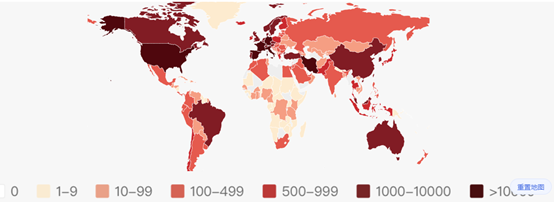
Global confirmed epidemic map | Source: Dr. Lilac
Difficulties
1. Production side: production capacity is still recovering and raw material prices are rising
The domestic epidemic situation has gradually improved. According to Feishu Shennuo’s survey, 70% -80% of domestic suppliers have resumed work, but it will take time for the upstream supply efficiency to fully return to normal levels, mainly because:
1) The factory is understaffed
Currently, some workers have not returned to the factory to work because of objective restrictions on epidemic prevention measures and subjective concerns about the epidemic.
2) Domestic raw material prices are rising
Because domestic raw material production has experienced a long gap, the price of raw materials has generally risen under the influence of market supply and demand, involving clothing, electronics, chemicals, medical and pharmaceutical, and paper industries. There is a 10% -20% increase. However, most of the companies surveyed said that the increase in raw material prices was within expectations.
3) Inconvenient procurement of foreign raw materials
The continued spread of overseas epidemics has led to prolonged procurement cycles for some imported raw materials, which has also dragged down the progress of capacity recovery.
2. Logistics: timeliness has dropped significantly, and costs have continued to rise
1) Aviation capacity declines
With the outbreak of overseas epidemics, some foreign airlines have extended the time for grounding flights to and from China. As Europe has become a severely affected area, flights to and from other regions, as well as flights between European countries, have also been severely curtailed. According to incomplete statistics, the capacity of the international aviation market decreased by more than 60% from March to March. The capacity of the belly cabin of passenger planes has dropped sharply, resulting in an increase in the length of air freight and a continuous rise in prices. Some e-commerce sellers said that the current overseas logistics is delayed by an average of 5-7 days, and the price of air cargo spaces has increased by more than 30%.
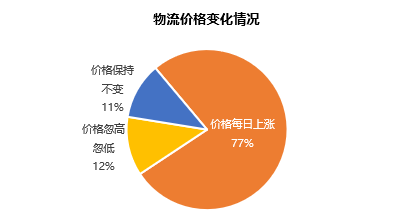
International logistics prices continue to rise | Source: Hugo.com
2) Insufficient logistics manpower
As countries with severe epidemics have gradually increased their epidemic prevention efforts, local residents are required to be separated from their homes. In the short term, there will be a shortage of logistics workers, especially affecting overseas “last mile” logistics, and the delivery speed will drop significantly.
3) Strengthened border controls
In Europe, since the outbreak, Italy, Spain, Germany, France, Austria, Switzerland, Czech Republic, Poland and other countries have closed borders or strengthened inspections to varying degrees. Goods (especially epidemic-related goods) have been delayed or even unable to be shipped. The risk of reaching this level has been greatly increased, and European land freight is severely restricted. As the epidemic escalates, more countries are expected to close their borders in Europe.
In the United States, according to feedback from a logistics company at Shenzhen Airport, after the epidemic prevention products such as masks arrived in the United States, they were intercepted during customs clearance, and the current status is mostly “warehouse left”.
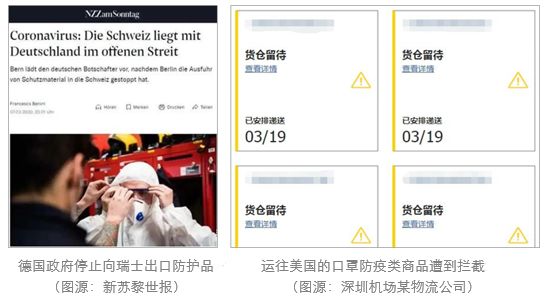
4) Adjustment of e-commerce platform logistics policy
Amazon FBA announced that it will only temporarily receive daily necessities and medical supplies during March 17-April 5th, resulting in most sellers will not be able to enter the warehouse. If you look for alternative overseas warehouses for warehousing, there is a big gap between the timeliness of logistics and FBA, which may lead to increased consumer complaints and returns, and increased operating costs.

Amazon FBA Announces Notification of Non-essential Products Suspension Stock | Image Source: Amazon
3. Consumers: purchasing demand has decreased, and the performance of various categories has declined.
(Description of related indicators: CTR means ad click rate, CTR = number of ad clicks / ad impressions * 100%; CVR means ad conversion rate, CVR = number of sales / ad link clicks * 100%)
1) ConsumerReduced consumer willingness to consume in the short term
With the escalation of epidemic prevention measures, consumers are confined to a relatively single living environment (home segregation), and the required goods will be reduced in the short term. In addition, due to concerns about viral transmission, logistics delays, and other factors, consumers may also actively reduce online purchases other than daily necessities. Feishu Shennuo data shows that due to the spread of the epidemic, China’s cross-border e-commerce advertising CVR continues to decline, which is significantly lower than the same period last year.
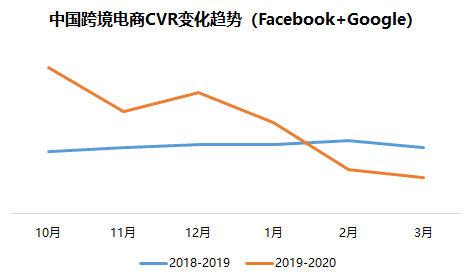
China’s cross-border e-commerce CVR goes down during the epidemic | Data source: Feishu Shennuo
2) Some categories are seriously affected
Feishu Shennuo’s research found that as more and more overseas countries implement large-scale isolation policies, consumers are forced to live at home for a long time. Changes in living conditions lead to corresponding changes in demand for different commodities. Research shows that although the demand for daily necessities such as clothing has declined, it is relatively stable compared to other categories; and the willingness to demand for consumer goods (such as outdoor sports, beauty products, etc.) that are suitable for specific scenarios has decreased significantly. The amount is gradually falling.
-
The CTR of clothing categories decreased slightly, and the CVR was basically stable:
After the outbreak of overseas epidemics, the CTR of apparel categories decreased slightly, reflecting that some overseas buyers have paid less attention to clothing and their willingness to consume. At the same time, the CVR is basically stable, which indicates that buyers with willingness to spend will still place orders for the clothing they currently need. We speculate that clothing is a necessity of daily life, and even if the home is segregated, home clothing needs to be purchased, and the demand always exists.
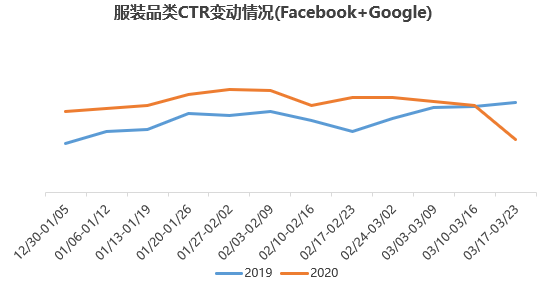

CTR of clothing category declined slightly, and CVR was basically stable | Data source: Feishu Shennuo
-
The CTR and CVR of outdoor sports categories have decreased significantly:
After the outbreak of overseas epidemic, the CTR of outdoor sports category has declined, and CVR has dropped significantly, reflecting that overseas buyers have reduced their willingness to consume this category, and among consumers who have clicked on ads and showed interest , The proportion of genuine purchases is also decreasing. We speculate that this is mainly because the outdoor sports category is a non-essential consumer product suitable for specific scenarios. With the epidemic spreading and the prevention and control upgrading, its demand is not urgent.
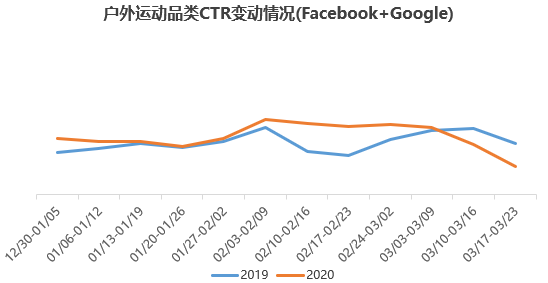
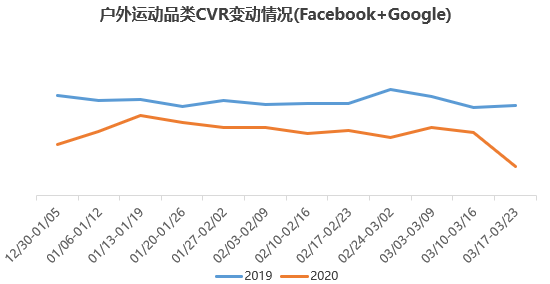
CTR and CVR in outdoor sports categories have decreased significantly. Data source: Feishu Shennuo
-
Both CTR and CVR in the beauty and health category have decreased significantly:
Qualitative research shows that after the domestic epidemic situation showed a positive trend at the end of February, some domestic sellers tried to sell epidemic prevention materials overseas, and the CTR and CVR of the beauty and health products were significantly upward. At the beginning of March, the overseas epidemic broke out, and the demand for beauty products ushered in an inflection point, and their U-turn declined. At the same time, overseas governments and media have gradually strengthened their control over health products. The superposition of many measures has led to a rapid decline in the CTR and CVR of beauty and health products.
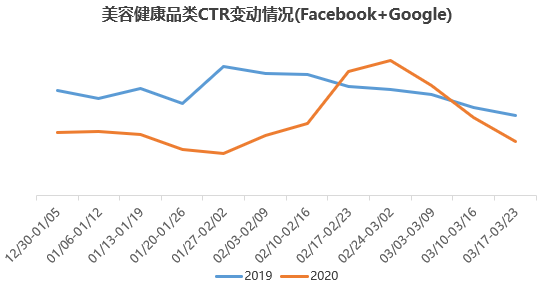
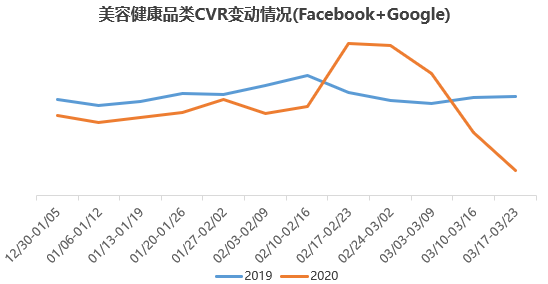
CTR and CVR in the beauty and health category both declined significantly. Data source: Feishu Shennuo
4. Marketing: Mask ads are banned and service efficiency is limited.
1) Media policy adjustments
During the epidemic, epidemic prevention materials in various places ran out, and consumer demand increased sharply. From Google Trends data, we can see that the search volume of epidemic prevention products such as masks has doubled during the epidemic. , Such as: Facebook and Google have issued policies prohibiting the placement of anti-epidemic ads.
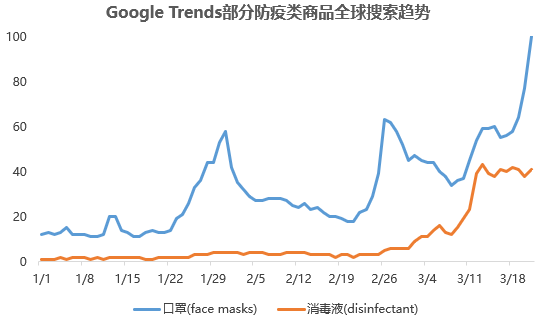
The number of searches for epidemic prevention products has increased sharply after the global epidemic broke out | Data source: Google Trends
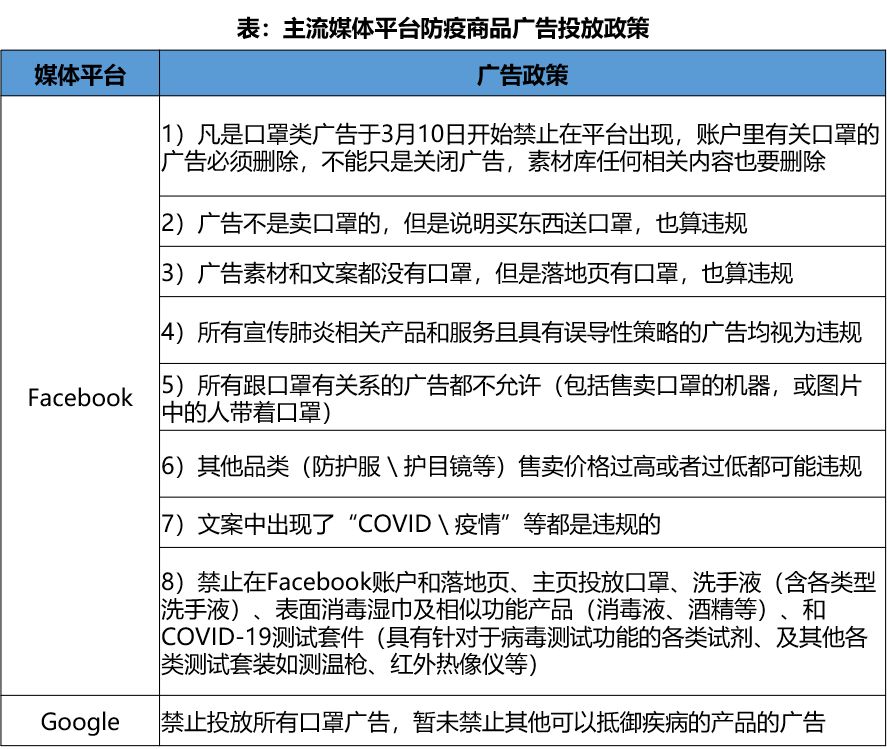
2) People work from home
Isolation policies issued by overseas countriesAfter the policy, more and more employees started to work from home, but reports show that the network in Britain, France, Germany, Spain and other countries has been overloaded. Telecom operators have called on local people to access the Internet reasonably, which has reduced the media platform to a certain extent. The efficiency of solving technical bugs or feedback on advertiser consultation will inevitably be affected.
Coping strategies
1. Optimize your own operations
1) Control the pace of delivery and reduce logistics complaints
Cross-border e-commerce sellers should control their own pace of shipments. For products sent to Europe, Japan, South Korea, the United States and other severely affected areas, more restrictions on customs clearance and logistics should be considered. At the same time, timely update logistics adjustment information on relevant pages of the website to inform customers of the current status of logistics and reduce their psychological expectations. Through the above measures, complaints and returns due to logistics delays are avoided as much as possible.
2) Layout protection products, expand related categories
The survey shows that 74.6% of U.S. respondents said that if the epidemic continues to worsen, they will avoid going to large shopping venues and instead shop online. Another survey also shows that the current demand for US consumer epidemic prevention products has increased significantly.
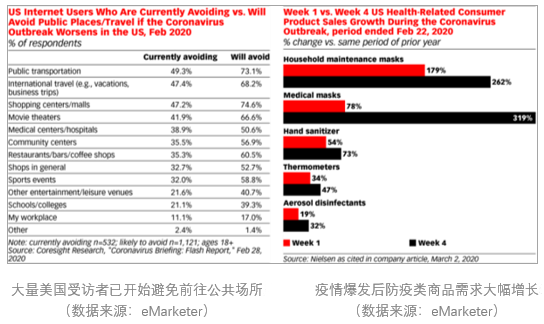
From domestic experience, we can see that epidemic prevention, home appliances (small household appliances, kitchen and bathroom supplies, home clothing), leisure and entertainment (game consoles, game auxiliary equipment, audio and video entertainment equipment), office equipment, 3C During the epidemic, the demand for categories such as categories increased sharply, and multiple explosions were born. It is speculated that with the spread of the epidemic, the above categories are expected to usher in demand climbing overseas in the future.
E-commerce companies can make appropriate adjustments accordingly: the layout of epidemic prevention products will be carried out in the short term, but attention needs to be paid to risks. The sales of epidemic prevention products have high entry barriers, require relevant qualifications, and are currently prohibited by social media Advertising on mask products; in the long term, some related products can be expanded. For example, clothing sellers can try to develop home textiles such as pajamas, but they also need to pay attention to risks, avoid cross-industry adjustments, and involve unknown areas.
3) Adjust operating strategies and optimize cash expenditures
Subject to the difficulties described above, it is more difficult to achieve high conversions in advertising in the hardest hit areas. Therefore, it is recommended that sellers pay attention to marketing strategies and tilt advertising expenditure to areas less affected by the epidemic to achieve a relatively stable ROI. At the same time, continue to strictly manage daily expenses to ensure healthy and controllable cash flow.
2. Seeking external support
After the outbreak,From the state to the local provinces, cities, and counties, a large number of support policies have been issued. The support targets are mainly small, medium and micro enterprises. A large number of small and medium factories and sellers on the cross-border e-commerce industry chain will benefit. According to media reports, as of March 14, the Agricultural Development Bank has supported a total of 2650 enterprises to resume work and production, and issued 137 billion yuan of loans, of which 78% were small, medium and micro enterprises.
In our previous cross-border “China E-commerce war “epidemic” guide (two): in-depth analysis of supply chain logistics and Analysis of China ’s cross-border e-commerce war” outbreak “cash flow analysis guide: three) a guide to the” Outbreak “of China ’s cross-border e-commerce war:” Three) guide (3) Under the worsening situation, it is recommended that cross-border e-commerce practitioners actively find and use appropriate policies to deal with the crisis.
Conclusion
The outbreak of overseas epidemics has greatly increased the logistics pressure faced by cross-border e-commerce sellers, and changes in overseas consumer demand have made some sellers difficult to sell. We analyze new problems that arise at the production, logistics, consumer, and marketing sides, and recommend that sellers optimize their operations, including controlling the pace of logistics, expanding related categories, and carefully arranging epidemic-related products to respond to market changes. At the same time, it actively seeks national policy support to ease funding pressure. We will also continue to pay attention to market changes and try our best to provide strategic suggestions to overcome difficulties with you.
▍Appendix
![Guidelines for the]()
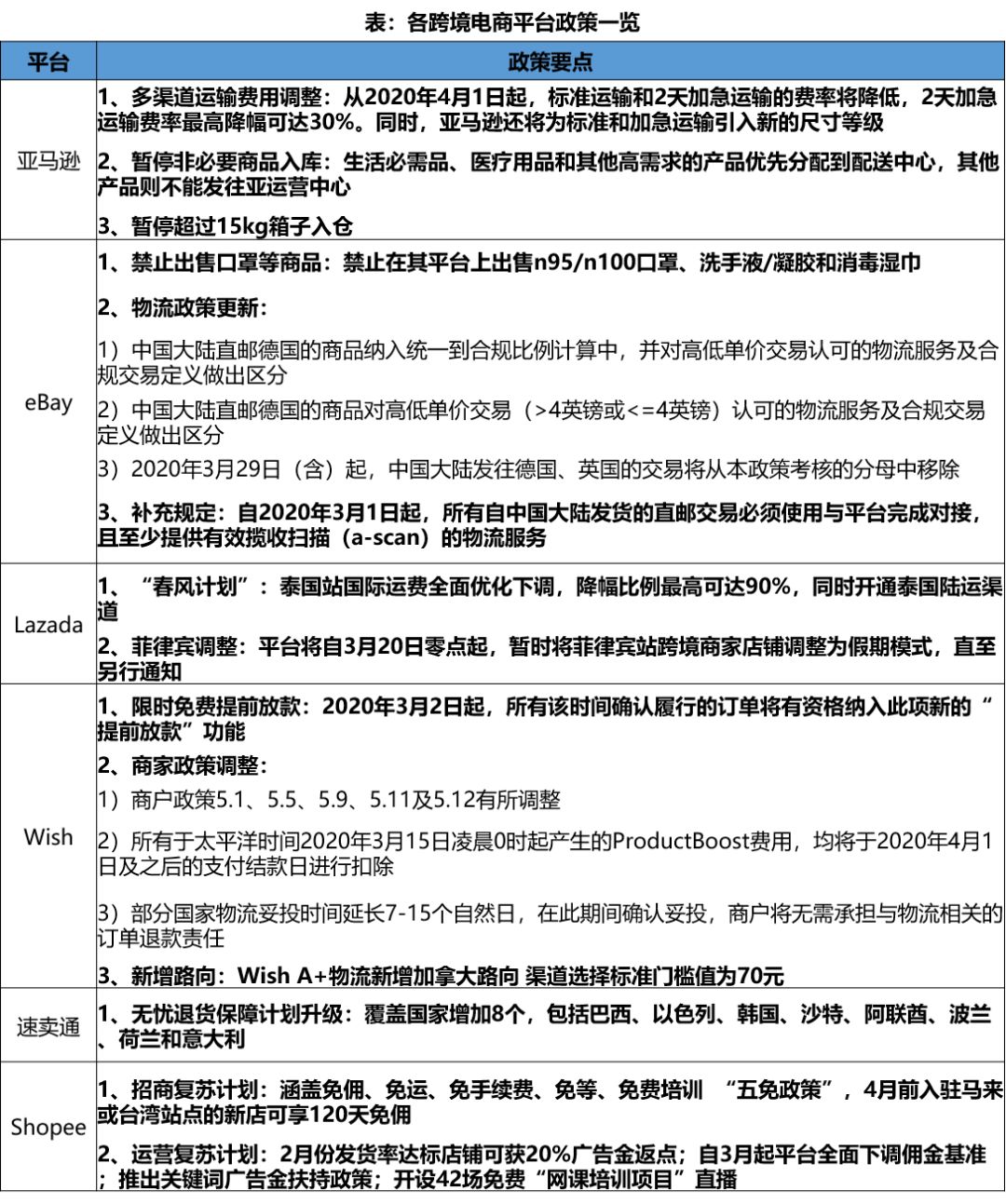
Edit | 云 晞 @ 出海



1. Production side: production capacity is still recovering and raw material prices are rising
The domestic epidemic situation has gradually improved. According to Feishu Shennuo’s survey, 70% -80% of domestic suppliers have resumed work, but it will take time for the upstream supply efficiency to fully return to normal levels, mainly because:
1) The factory is understaffed
Currently, some workers have not returned to the factory to work because of objective restrictions on epidemic prevention measures and subjective concerns about the epidemic.
2) Domestic raw material prices are rising
Because domestic raw material production has experienced a long gap, the price of raw materials has generally risen under the influence of market supply and demand, involving clothing, electronics, chemicals, medical and pharmaceutical, and paper industries. There is a 10% -20% increase. However, most of the companies surveyed said that the increase in raw material prices was within expectations.
3) Inconvenient procurement of foreign raw materials
The continued spread of overseas epidemics has led to prolonged procurement cycles for some imported raw materials, which has also dragged down the progress of capacity recovery.
2. Logistics: timeliness has dropped significantly, and costs have continued to rise
1) Aviation capacity declines
With the outbreak of overseas epidemics, some foreign airlines have extended the time for grounding flights to and from China. As Europe has become a severely affected area, flights to and from other regions, as well as flights between European countries, have also been severely curtailed. According to incomplete statistics, the capacity of the international aviation market decreased by more than 60% from March to March. The capacity of the belly cabin of passenger planes has dropped sharply, resulting in an increase in the length of air freight and a continuous rise in prices. Some e-commerce sellers said that the current overseas logistics is delayed by an average of 5-7 days, and the price of air cargo spaces has increased by more than 30%.

International logistics prices continue to rise | Source: Hugo.com
2) Insufficient logistics manpower
As countries with severe epidemics have gradually increased their epidemic prevention efforts, local residents are required to be separated from their homes. In the short term, there will be a shortage of logistics workers, especially affecting overseas “last mile” logistics, and the delivery speed will drop significantly.
3) Strengthened border controls
In Europe, since the outbreak, Italy, Spain, Germany, France, Austria, Switzerland, Czech Republic, Poland and other countries have closed borders or strengthened inspections to varying degrees. Goods (especially epidemic-related goods) have been delayed or even unable to be shipped. The risk of reaching this level has been greatly increased, and European land freight is severely restricted. As the epidemic escalates, more countries are expected to close their borders in Europe.
In the United States, according to feedback from a logistics company at Shenzhen Airport, after the epidemic prevention products such as masks arrived in the United States, they were intercepted during customs clearance, and the current status is mostly “warehouse left”.

4) Adjustment of e-commerce platform logistics policy
Amazon FBA announced that it will only temporarily receive daily necessities and medical supplies during March 17-April 5th, resulting in most sellers will not be able to enter the warehouse. If you look for alternative overseas warehouses for warehousing, there is a big gap between the timeliness of logistics and FBA, which may lead to increased consumer complaints and returns, and increased operating costs.

Amazon FBA Announces Notification of Non-essential Products Suspension Stock | Image Source: Amazon
3. Consumers: purchasing demand has decreased, and the performance of various categories has declined.
(Description of related indicators: CTR means ad click rate, CTR = number of ad clicks / ad impressions * 100%; CVR means ad conversion rate, CVR = number of sales / ad link clicks * 100%)
1) ConsumerReduced consumer willingness to consume in the short term
With the escalation of epidemic prevention measures, consumers are confined to a relatively single living environment (home segregation), and the required goods will be reduced in the short term. In addition, due to concerns about viral transmission, logistics delays, and other factors, consumers may also actively reduce online purchases other than daily necessities. Feishu Shennuo data shows that due to the spread of the epidemic, China’s cross-border e-commerce advertising CVR continues to decline, which is significantly lower than the same period last year.

China’s cross-border e-commerce CVR goes down during the epidemic | Data source: Feishu Shennuo
2) Some categories are seriously affected
Feishu Shennuo’s research found that as more and more overseas countries implement large-scale isolation policies, consumers are forced to live at home for a long time. Changes in living conditions lead to corresponding changes in demand for different commodities. Research shows that although the demand for daily necessities such as clothing has declined, it is relatively stable compared to other categories; and the willingness to demand for consumer goods (such as outdoor sports, beauty products, etc.) that are suitable for specific scenarios has decreased significantly. The amount is gradually falling.
-
The CTR of clothing categories decreased slightly, and the CVR was basically stable:
After the outbreak of overseas epidemics, the CTR of apparel categories decreased slightly, reflecting that some overseas buyers have paid less attention to clothing and their willingness to consume. At the same time, the CVR is basically stable, which indicates that buyers with willingness to spend will still place orders for the clothing they currently need. We speculate that clothing is a necessity of daily life, and even if the home is segregated, home clothing needs to be purchased, and the demand always exists.
CTR of clothing category declined slightly, and CVR was basically stable | Data source: Feishu Shennuo
-
The CTR and CVR of outdoor sports categories have decreased significantly:
After the outbreak of overseas epidemic, the CTR of outdoor sports category has declined, and CVR has dropped significantly, reflecting that overseas buyers have reduced their willingness to consume this category, and among consumers who have clicked on ads and showed interest , The proportion of genuine purchases is also decreasing. We speculate that this is mainly because the outdoor sports category is a non-essential consumer product suitable for specific scenarios. With the epidemic spreading and the prevention and control upgrading, its demand is not urgent.
CTR and CVR in outdoor sports categories have decreased significantly. Data source: Feishu Shennuo
-
Both CTR and CVR in the beauty and health category have decreased significantly:
Qualitative research shows that after the domestic epidemic situation showed a positive trend at the end of February, some domestic sellers tried to sell epidemic prevention materials overseas, and the CTR and CVR of the beauty and health products were significantly upward. At the beginning of March, the overseas epidemic broke out, and the demand for beauty products ushered in an inflection point, and their U-turn declined. At the same time, overseas governments and media have gradually strengthened their control over health products. The superposition of many measures has led to a rapid decline in the CTR and CVR of beauty and health products.
CTR and CVR in the beauty and health category both declined significantly. Data source: Feishu Shennuo
4. Marketing: Mask ads are banned and service efficiency is limited.
1) Media policy adjustments
During the epidemic, epidemic prevention materials in various places ran out, and consumer demand increased sharply. From Google Trends data, we can see that the search volume of epidemic prevention products such as masks has doubled during the epidemic. , Such as: Facebook and Google have issued policies prohibiting the placement of anti-epidemic ads.
The number of searches for epidemic prevention products has increased sharply after the global epidemic broke out | Data source: Google Trends
2) People work from home
Isolation policies issued by overseas countriesAfter the policy, more and more employees started to work from home, but reports show that the network in Britain, France, Germany, Spain and other countries has been overloaded. Telecom operators have called on local people to access the Internet reasonably, which has reduced the media platform to a certain extent. The efficiency of solving technical bugs or feedback on advertiser consultation will inevitably be affected.
Coping strategies
1. Optimize your own operations
1) Control the pace of delivery and reduce logistics complaints
Cross-border e-commerce sellers should control their own pace of shipments. For products sent to Europe, Japan, South Korea, the United States and other severely affected areas, more restrictions on customs clearance and logistics should be considered. At the same time, timely update logistics adjustment information on relevant pages of the website to inform customers of the current status of logistics and reduce their psychological expectations. Through the above measures, complaints and returns due to logistics delays are avoided as much as possible.
2) Layout protection products, expand related categories
The survey shows that 74.6% of U.S. respondents said that if the epidemic continues to worsen, they will avoid going to large shopping venues and instead shop online. Another survey also shows that the current demand for US consumer epidemic prevention products has increased significantly.
From domestic experience, we can see that epidemic prevention, home appliances (small household appliances, kitchen and bathroom supplies, home clothing), leisure and entertainment (game consoles, game auxiliary equipment, audio and video entertainment equipment), office equipment, 3C During the epidemic, the demand for categories such as categories increased sharply, and multiple explosions were born. It is speculated that with the spread of the epidemic, the above categories are expected to usher in demand climbing overseas in the future.
E-commerce companies can make appropriate adjustments accordingly: the layout of epidemic prevention products will be carried out in the short term, but attention needs to be paid to risks. The sales of epidemic prevention products have high entry barriers, require relevant qualifications, and are currently prohibited by social media Advertising on mask products; in the long term, some related products can be expanded. For example, clothing sellers can try to develop home textiles such as pajamas, but they also need to pay attention to risks, avoid cross-industry adjustments, and involve unknown areas.
3) Adjust operating strategies and optimize cash expenditures
Subject to the difficulties described above, it is more difficult to achieve high conversions in advertising in the hardest hit areas. Therefore, it is recommended that sellers pay attention to marketing strategies and tilt advertising expenditure to areas less affected by the epidemic to achieve a relatively stable ROI. At the same time, continue to strictly manage daily expenses to ensure healthy and controllable cash flow.
2. Seeking external support
After the outbreak,From the state to the local provinces, cities, and counties, a large number of support policies have been issued. The support targets are mainly small, medium and micro enterprises. A large number of small and medium factories and sellers on the cross-border e-commerce industry chain will benefit. According to media reports, as of March 14, the Agricultural Development Bank has supported a total of 2650 enterprises to resume work and production, and issued 137 billion yuan of loans, of which 78% were small, medium and micro enterprises.
In our previous cross-border “China E-commerce war “epidemic” guide (two): in-depth analysis of supply chain logistics and Analysis of China ’s cross-border e-commerce war” outbreak “cash flow analysis guide: three) a guide to the” Outbreak “of China ’s cross-border e-commerce war:” Three) guide (3) Under the worsening situation, it is recommended that cross-border e-commerce practitioners actively find and use appropriate policies to deal with the crisis.
Conclusion
The outbreak of overseas epidemics has greatly increased the logistics pressure faced by cross-border e-commerce sellers, and changes in overseas consumer demand have made some sellers difficult to sell. We analyze new problems that arise at the production, logistics, consumer, and marketing sides, and recommend that sellers optimize their operations, including controlling the pace of logistics, expanding related categories, and carefully arranging epidemic-related products to respond to market changes. At the same time, it actively seeks national policy support to ease funding pressure. We will also continue to pay attention to market changes and try our best to provide strategic suggestions to overcome difficulties with you.
▍Appendix
Edit | 云 晞 @ 出海
-
-